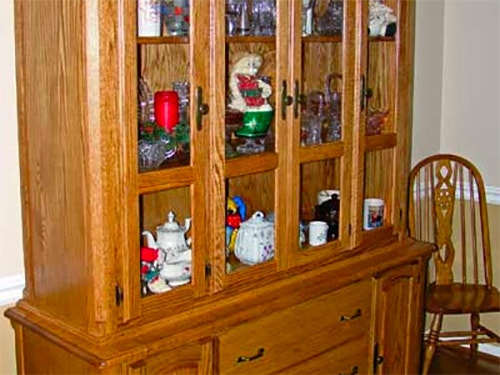Refinishing Wood Furniture
I have a 60-year-old hutch that my dad had made for my grandmom as a Mother's Day gift. The finish is worn in spots and cracked, so I want to refinish it. The problem is that, on the sides, he used some type of plywood, similar to an oak plywood you can buy at Home Depot. Since when I strip it there is a good chance of wearing through the thin "oak" layer, I want to finish using something that has a solid color. I am experienced at using plain polyurethane, but I have never attempted coloring. What would you recommend using for a project such as this? Any help would be appreciated.
The plan is to restore it and give it to one of my kids...you can tell he spent a lot of time with the intricate cuts and design (my dad was a complete perfectionist with everything); it just needs some attention after 60 years! - Norris Pyle
Tim Inman: I'm going to suggest that you have it right in your last sentence: "It just needs some attention...." Sometimes, a total finish removal and replacement is necessary. From your description, it doesn't sound to me like that is that case here. I would first try a gentle "conservation cleaning" approach. Use mild solvents like mineral spirits and a bit of nylon scruffie or steel wool to remove the grime and decayed finish. Step up the strength as needed with the addition of some alcohol or even some lacquer thinner. Obviously, this is a very flammable brew, so take all fire safety precautions and work in a well ventilated place. Use safety gear like gloves and glasses, etc. Once you've cleaned off the offending old finishes - but not everything! - then restain and add compensating color as needed. Seal with a shellac wash because a very thin dilution of shellac and alcohol will usually bring up the colors, and seal in some bad things we don't have the space here to deal with. Once that is dry, you can re-re-color if needed. Seal again if needed. When you're happy (remember: perfect is the enemy of good!), then build up a new surface film to protect your hutch. Several thinned coats are almost always superior to one or two "slathered thick" ones.
Chris Marshall: Norris, go with Tim's approach first: try to clean your hutch's finish before scouring it off, because once the old finish is truly gone, you can't get it back again. If you determine that more drastic measures are really, truly needed here, it sounds like stripping your hutch is very doable without damaging the wood. If the oak veneer on the plywood sides of your hutch is in good condition (not blistered, loose or cracked), and just the finish is cracked and in need of help, all the better! Given the vintage of this hutch, it wasn't top coated with polyurethane or probably even varnish. Chances are, your dad stained or dyed the project first to color the raw wood, then top coated it with shellac. I'd try one of the thick liquid or semi-paste strippers. Check the label, which will tell you the chemicals it contains. Try the stripper in an inconspicuous area of the hutch to see what happens. It should strip off shellac very easy, and probably the underlying stain, too. You don't have to sand the wood this way and risk sanding through the thin plywood veneer. Use a scrub pad and rub the old finish off instead. Give the stripper time to do its work, undisturbed, before you wipe it away, for best effect. Then, once the finish is off, I'd re-stain the wood in a transparent color you like and enhance that old wood grain again. I wouldn't cover it up with a solid color, similar to painting. The grain pattern is part of what gives this heirloom hutch its character. Make the most of it!
Keep the inspiration coming!
Subscribe to our newsletter for more woodworking tips and tricks



